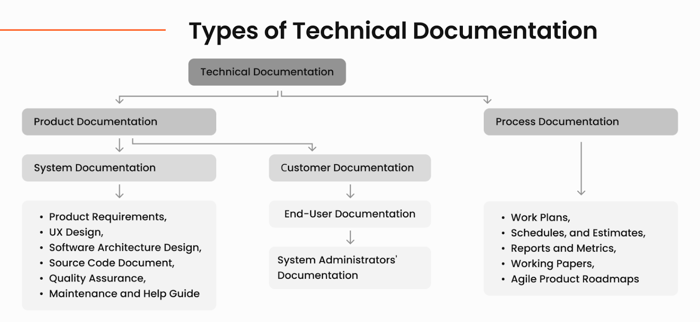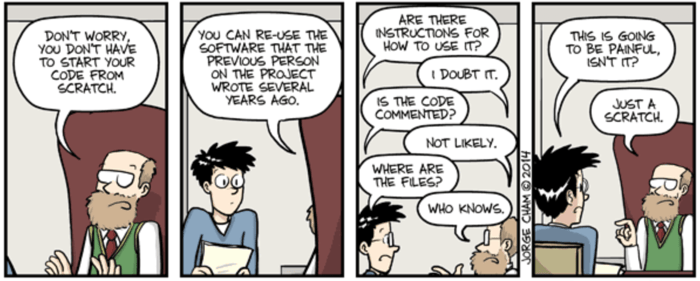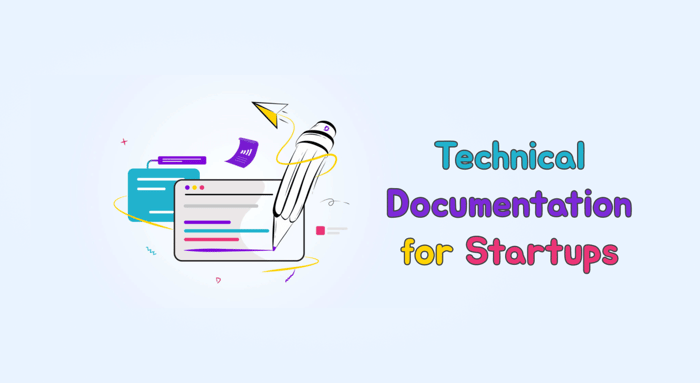Table of Contents
Understand why and how to implement technical documentation in startups
Technical documentation is crucial for startups, serving as a vital link between product development and effective communication. In the dynamic environment of early-stage startups, technical documentation offers a framework for maintaining clarity and consistency amidst rapid innovation. Documenting processes, systems, and product details allows startups to efficiently share knowledge, reducing the risk of technical debt and enhancing collaboration among team members. This is particularly important for startups with limited resources, where clear communication is vital to avoiding delays and costly errors.
At its core, technical documentation encompasses a range of materials, including user manuals, API references, system architecture diagrams, and internal processes. Well-structured documentation streamlines onboarding, ensures smoother product development, and acts as a reliable reference for ongoing technical work. It enables teams to focus on innovation without sacrificing clarity or duplicating work due to communication gaps. Moreover, it supports the creation of a sustainable, scalable product as the startup expands, facilitating the onboarding of new developers and stakeholders and the transfer of essential knowledge.
This article will explore the essential role technical documentation plays in the early stages of a startup, diving into the types of documentation that are most effective, common challenges startups face, and practical solutions for integrating documentation into fast-paced workflows. By understanding these key elements, founders and teams can leverage documentation as a tool to build strong foundations for long-term success, even when moving at startup speed.
Types of Technical Documentation

Startups require various types of technical documentation to ensure efficient development and smooth operations. Understanding these categories helps teams create comprehensive documentation that supports both internal operations and external user needs.
Product Documentation: User manuals provide step-by-step instructions on how to use the product, ensuring customers can effectively utilize its features. Release notes keep users informed about new features, bug fixes, and improvements in each version. API documentation is crucial for developers integrating the product, offering detailed information on endpoints, request/response formats, and authentication methods.
System Documentation: Architecture diagrams visually represent the system's structure, showing how different components interact. System requirements outline the hardware and software needed to run the product efficiently. Source code documentation, embedded within the codebase, explains complex algorithms and functions. Deployment guides ensure consistent and error-free installation across different environments.
Process Documentation: Development workflows describe the steps from ideation to deployment, ensuring all team members follow the same process. Coding standards maintain consistency in code style and quality across the project. Testing procedures outline how to verify product functionality, including unit tests, integration tests, and user acceptance testing protocols.
Customer Support Documentation: Troubleshooting guides provide solutions to common problems, reducing support ticket volume. FAQs answer frequently asked questions, serving as a first line of support for users. Customer support playbooks equip support teams with standardized responses and escalation procedures, ensuring consistent and high-quality customer service.
By developing and maintaining these types of documentation, startups can improve product usability, streamline internal processes, and provide better support to their users, ultimately contributing to the company's growth and success.
Why Startups Often Overlook Documentation
Technical documentation often gets neglected in the fast-paced business environment, despite its critical role in ensuring long-term success. This oversight can be attributed to various factors inherent to businesses.
Young enterprises are typically driven by an intense focus on speed and the creation of a Minimum Viable Product (MVP). In the race to bring their product to market, founders and developers prioritize building and refining core features that can swiftly validate their business model. This emphasis on rapid development and deployment often leaves little time for what may be perceived as non-essential tasks such as documentation. The mantra "move fast and break things" inadvertently relegates documentation to a lower priority.
The issue is further compounded by limited resources. Young businesses usually operate with small teams and tight deadlines. Given that each team member often plays multiple roles, the allocation of time and effort towards documentation may seem like a luxury they cannot afford. When faced with the choice between writing code for a new feature or documenting an existing one, the immediate pressure to deliver typically takes precedence.
There is also a prevalent misconception that documentation is secondary to product development. Many startup founders and developers view documentation as something that can be "added later" once the product gains traction. This perspective fails to recognize documentation as an integral part of the product development process itself. The belief that good code is self-documenting or that team members will remember critical information without formal documentation can lead to significant challenges as the startup grows.
This oversight can result in accumulated technical debt, difficulties in onboarding new team members, and challenges in maintaining and scaling the product. As startups evolve, the lack of proper documentation can become a significant bottleneck, hindering growth and efficiency. Recognizing the value of documentation early on and integrating it into the development process can save businesses considerable time and resources in the long run.
Challenges of Technical Documentation for Startups

Technical documentation presents unique challenges for startups, largely due to their dynamic nature and resource limitations. Below is a refined exploration of these challenges:
Maintenance: Rapid iterations and constant changes in the codebase make it difficult to keep the documentation current. Features are frequently added, modified, or removed, causing existing documentation to quickly become outdated. This poses a significant risk, as outdated documentation can lead to confusion, miscommunication, and errors, often creating more problems than no documentation at all. Startups need agile processes to update the documentation in real-time with product development.
Time Constraints: Time is a scarce resource, and teams are constantly under pressure to deliver new features and improvements. As a result, documentation is often deprioritized in favor of immediate product development. The challenge lies in balancing the need to ship new features quickly with the long-term value of maintaining accurate documentation. Without proper documentation, startups may sacrifice clarity and face technical debt down the line, which can slow down growth and scalability.
Lack of Dedicated Roles: Young businesses typically operate with lean teams, where employees take on multiple responsibilities. Without dedicated technical writers or documentation specialists, the responsibility for maintaining documentation often falls on developers or product managers. These individuals may not have the bandwidth, expertise, or inclination to focus on documentation, resulting in lower-quality records that lack depth and consistency.
Consistency and Quality Control: Without standardized processes or personnel focused on documentation, maintaining consistency across different documents becomes challenging. Variations in style, format, and depth can fragment the user experience and make it difficult to ensure that documentation is up-to-date, accurate, and aligned with the product’s evolution.
Technical Debt Accumulation: As young entreprises prioritize rapid product development, technical debt—both in code and documentation—accumulates. The longer documentation is neglected, the harder and more time-consuming it becomes to create comprehensive and accurate records later on.
Knowledge Silos: In small teams, critical information often resides in the minds of individual team members. This creates knowledge silos that are risky, especially if key employees leave or are unavailable. Without proper documentation, the knowledge gap becomes increasingly difficult to bridge.
Evolving Product Vision: These businesses frequently pivot or alter their product direction based on market feedback, making it challenging to maintain accurate documentation. The fluidity of the product vision requires a flexible documentation approach, or it risks becoming outdated quickly.
Tool Selection and Integration: Choosing the right documentation tools and integrating them into a startup’s workflow can be tricky. Startups need tools that are not only easy to use but also scalable as the company grows, and this selection process can sometimes be overlooked or rushed.
Balancing Detail and Brevity: Young enterprises must find a balance between providing enough detail for clarity and keeping documentation concise and digestible. Over-documentation can overwhelm users and team members, while under-documentation may leave gaps in understanding, hindering both internal processes and customer support.
Addressing these challenges requires intentional planning from the outset. By embedding documentation practices into the development process and allocating resources effectively, startups can create a robust foundation that supports future growth, scalability, and smoother operations.
Best Practices for Creating Technical Documentation in Startups
Creating effective technical documentation requires a strategic approach that balances thoroughness with efficiency. Startups face unique challenges, such as limited resources, fast-paced development, and constant change, making it crucial to adopt best practices that ensure documentation remains relevant and valuable. Here are some best practices that can help establish a strong documentation culture:
Start Early: Incorporating documentation from the very start is critical. Many startups in emerging markets, often prioritize product delivery over documentation, but this leads to gaps in knowledge transfer later on. By integrating documentation into development from day one, startups can reduce technical debt, ensure key insights are captured in real-time, and create a culture where documentation is consistently valued.
Keep it Simple: It’s easy to overlook this aspect, but avoiding unnecessary jargon and using plain language ensures that both technical and non-technical team members understand the documentation. For example, using diagrams to explain a product’s architecture can make complex systems understandable, especially when training new hires or collaborating with external partners.
Automate Where Possible: Leveraging automation tools can significantly ease the documentation burden. Tools like Swagger or OpenAPI can automatically generate API documentation, reducing manual work. Automation can also be used to track changes with commit messages, ensuring that documentation evolves alongside the codebase.
Make It Collaborative: Young enterprises thrive on collaboration, and this should extend to documentation. Encouraging everyone on the team to contribute using platforms like GitHub or Notion can improve both the quality and accuracy of documentation. Involving the entire team creates shared ownership, making it easier to update and maintain the documentation over time. Regular peer reviews can further enhance the quality, similar to how code is reviewed.
Use Templates and Style Guides: Developing standardized templates for different documentation types (like user guides and API docs) ensures uniformity across the board. Creating a style guide will help maintain a consistent tone and structure, making the documentation easier to follow.
Gather and Act on Feedback: Documentation isn’t just for internal use—feedback from external users can provide valuable insights. Including feedback mechanisms within the documentation, such as surveys or comment sections, can help teams understand user pain points and make improvements.
Integrate Documentation into the Development Workflow: Finally, to ensure documentation is consistently maintained, it must be integrated into the development workflow. Documentation tasks should be part of sprint planning, and teams should set up reminders to update documents whenever there are code changes.
By following these best practices, young businesses can create high-quality, sustainable technical documentation that scales with their growth. Proper documentation improves team efficiency, enhances product quality, and reduces onboarding time for new hires, ultimately providing long-term value at every stage of the startup’s development.
Tools and Platforms for Managing Documentation
Selecting the right tools and platforms for managing technical documentation is vital to streamline the documentation process and foster a culture of collaboration. The choice of tools can significantly impact the ease of creating, maintaining, and updating documentation as the startup grows. Here’s an overview of key categories and popular tools that can support effective documentation management:
1. Version Control Systems
Version control systems are fundamental for tracking changes, collaborating on documentation, and maintaining a history of updates. They ensure consistency and provide transparency in the evolution of documentation.
GitHub: Widely used for both code and documentation, GitHub offers powerful features like wikis, markdown support, and GitHub Pages for hosting documentation. Its seamless integration with development workflows makes it ideal for teams already using Git for version control.
GitLab: GitLab offers similar functionality to GitHub but with additional self-hosted options for startups wanting greater control over their data. It also includes built-in CI/CD pipelines that can automate documentation deployment alongside code updates.
2. Documentation Tools
These tools are purpose-built for creating, managing, and publishing technical documentation, often integrating well with version control systems.
ReadTheDocs: Popular among open-source projects, ReadTheDocs automatically builds and hosts documentation directly from version-controlled repositories. It supports multiple versions and languages, making it a versatile choice for projects with varying documentation needs.
MkDocs: A simple, fast static site generator, MkDocs is tailored for project documentation. It uses Markdown for writing and offers themes and plugins for customization. Businesses seeking a lightweight, easy-to-use documentation tool will find MkDocs efficient and adaptable.
Docusaurus: Developed by Facebook, Docusaurus is optimized for React-based documentation, offering versioning, search, and internationalization features. It provides the flexibility to customize while maintaining ease of use, making it a solid option for tech teams using React.
3. Collaborative Platforms
Collaboration is critical, and platforms that facilitate real-time editing and team contributions can be game-changers for internal documentation.
Confluence: Part of Atlassian’s suite, Confluence integrates seamlessly with Jira and other development tools. It offers robust permission settings, customizable templates, and strong search capabilities, making it ideal for teams that need structured documentation with access control.
Notion: Notion provides a flexible, user-friendly interface combining notes, databases, and wikis. Its adaptability makes it suitable for both technical and non-technical documentation, offering startups a single platform for diverse documentation needs.
Google Docs: Google Docs is widely used due to its real-time collaboration features and ease of use. It’s ideal for businesses needing quick, simple documentation that non-technical team members can also contribute to. Integration with Google Workspace makes it even more convenient for team collaboration.
4. API Documentation Tools
API documentation is critical in startups, particularly for products with external developer users. These tools simplify the process of creating, managing, and sharing API documentation.
Swagger (OpenAPI): Swagger is the industry standard for describing RESTful APIs and offers both open-source tools and enterprise solutions. It can generate interactive documentation and client SDKs, making API documentation easier for developers to consume and use.
Postman: While primarily known for API testing, Postman also provides robust features for creating and sharing API documentation. Its collaborative workflows enable teams to develop and document APIs efficiently, streamlining the process for both internal and external stakeholders.
5. Additional Tools Worth Mentioning
For startups with specific needs, these tools offer unique features and can be worth considering for managing and scaling documentation.
GitBook: GitBook is a modern platform that emphasizes beautiful, easy-to-navigate documentation. It includes versioning, multi-language support, and analytics, making it a good choice for startups looking to enhance their documentation’s visual appeal and track its usage.
Docsify: A lightweight, Vue-powered documentation generator, Docsify doesn’t require static HTML files, making it incredibly fast to set up. It’s ideal for startups needing a quick, simple solution for documentation without heavy dependencies.
Sphinx: Sphinx is particularly popular in the Python community and offers powerful features for cross-referencing and indexing. Its ability to handle complex, structured documentation makes it a good choice for startups working with Python-based projects.
Stoplight: Stoplight specializes in API design and documentation, offering visual API design tools and style guides to ensure consistency. It’s an excellent choice for startups focusing heavily on API development and looking to maintain high standards in their API documentation.
Key Considerations for Choosing Documentation Tools
When selecting documentation tools, startups should weigh several factors:
Ease of Use: Tools should be intuitive and have a low learning curve, allowing team members to adopt them quickly.
Integration: Look for tools that integrate well with existing workflows, such as development pipelines, CI/CD systems, or project management tools.
Scalability: As the startup grows, so will the documentation needs. Choose tools that can scale with the team and product without requiring significant overhauls.
Cost: Many startups are budget-conscious, so it’s important to consider free or open-source options, as well as pricing for enterprise solutions as the team expands.
Collaboration: Tools should allow real-time collaboration and version control, ensuring multiple contributors can work on the documentation without conflicts.
Support for Formats: The ability to work with different documentation formats like Markdown, reStructuredText, or HTML can be critical depending on the technical complexity of the documentation.
Choosing the right tools for managing documentation is essential for maintaining efficiency and supporting growth. Starting with lightweight, easy-to-use tools and scaling to more complex solutions as the team expands ensures that documentation remains an asset rather than a burden. By selecting tools that integrate seamlessly with workflows and encourage collaboration, startups can build a documentation culture that supports their long-term success.
How to Ensure Documentation Quality
Ensuring high-quality documentation is key to keeping technical content relevant, accurate, and user-friendly. Here's a breakdown of strategies for achieving and maintaining documentation excellence:
1. Consistent Style and Formatting
Consistency ensures that users can easily navigate and understand documentation, no matter who wrote it. Here are some ways to ensure a consistent documentation style and format:
Develop a style guide: Ensure consistency in writing style, whether formal or informal. Develop guidelines for formatting, including headers, code blocks, and lists. Clearly define terminology, preferred language usage, and standards for naming files.
Use templates: Furnish templates for various documentation types like API documentation, onboarding guides, etc. Make sure to include critical sections to avoid any missing information.
Automated style checks: Utilize tools such as Vale or write-good for enforcing style rules, and incorporate these checks into CI/CD pipelines to achieve continuous enforcement.
2. Regular Updates
Documentation becomes outdated quickly if not regularly updated alongside product changes. To ensure documentation is up to date, practice the following:
Integrate with development cycles: Ensure that documentation updates are linked to sprints or releases, and clearly define documentation tasks during sprint planning.
Review and audit frequently: Ensure regular audits are scheduled to maintain up-to-date documentation. Implement version control for documentation, such as using Git branching for different releases.
3. Peer Review and Feedback
Collaboration ensures documentation is accurate, clear, and complete. The following practices are important:
Formal review process: Approach documentation reviews with the same rigor as code reviews by leveraging pull or merge requests. Foster input from cross-functional teams to gain diverse perspectives and deeper insights.
User feedback: Incorporate interactive mechanisms such as "Was this helpful?" buttons to collect user feedback. Analyze the feedback consistently and integrate suggestions for continuous quality improvement.
4. Automated Quality Checks
Automation ensures continuous quality control, catching errors before they are published. Here are some ways to automate quality checks:
Linters and link checkers: Ensure formatting rules are enforced by using Markdown linters. To guarantee all links are functional, consider using tools like Broken Link Checker or CI/CD-integrated tools.
CI/CD integration: Include documentation in the CI/CD pipeline for ongoing quality checks on structure, spelling, and style.
5. Readability and Accessibility
High-quality documentation must be easy to understand and accessible to all users. Some ways to achieve this are:
Use readability tools: Consider utilizing tools such as Grammarly or Hemingway Editor to enhance the readability of your content to better resonate with your target audience.
Accessibility practices: Include structure headings for screen readers, provide alt text for images, and ensure that color contrast meets accessibility guidelines.
By adopting these strategies, startups can ensure their technical documentation remains high-quality, scalable, and aligned with their product's evolution. The process of maintaining documentation quality is ongoing and needs to be embedded in the company's culture and development practices.
Conclusion
The importance of technical documentation cannot be overstated, especially for young businesses. In this article, we've explored the various types of documentation, challenges faced by startups, and best practices for maintaining high-quality documentation. The main point is this: investing in documentation early on leads to long-term benefits.
By giving priority to documentation from the outset, startups can minimize technical debt, foster better team collaboration, expedite onboarding, and ultimately improve product quality. Despite real constraints on resources and time, the enduring advantages of robust documentation far outweigh the initial investment.
Don't wait until you're struggling to catch up. Your future self, your team, and your customers will be grateful.
Akava would love to help your organization adapt, evolve and innovate your modernization initiatives. If you’re looking to discuss, strategize or implement any of these processes, reach out to [email protected] and reference this post.





